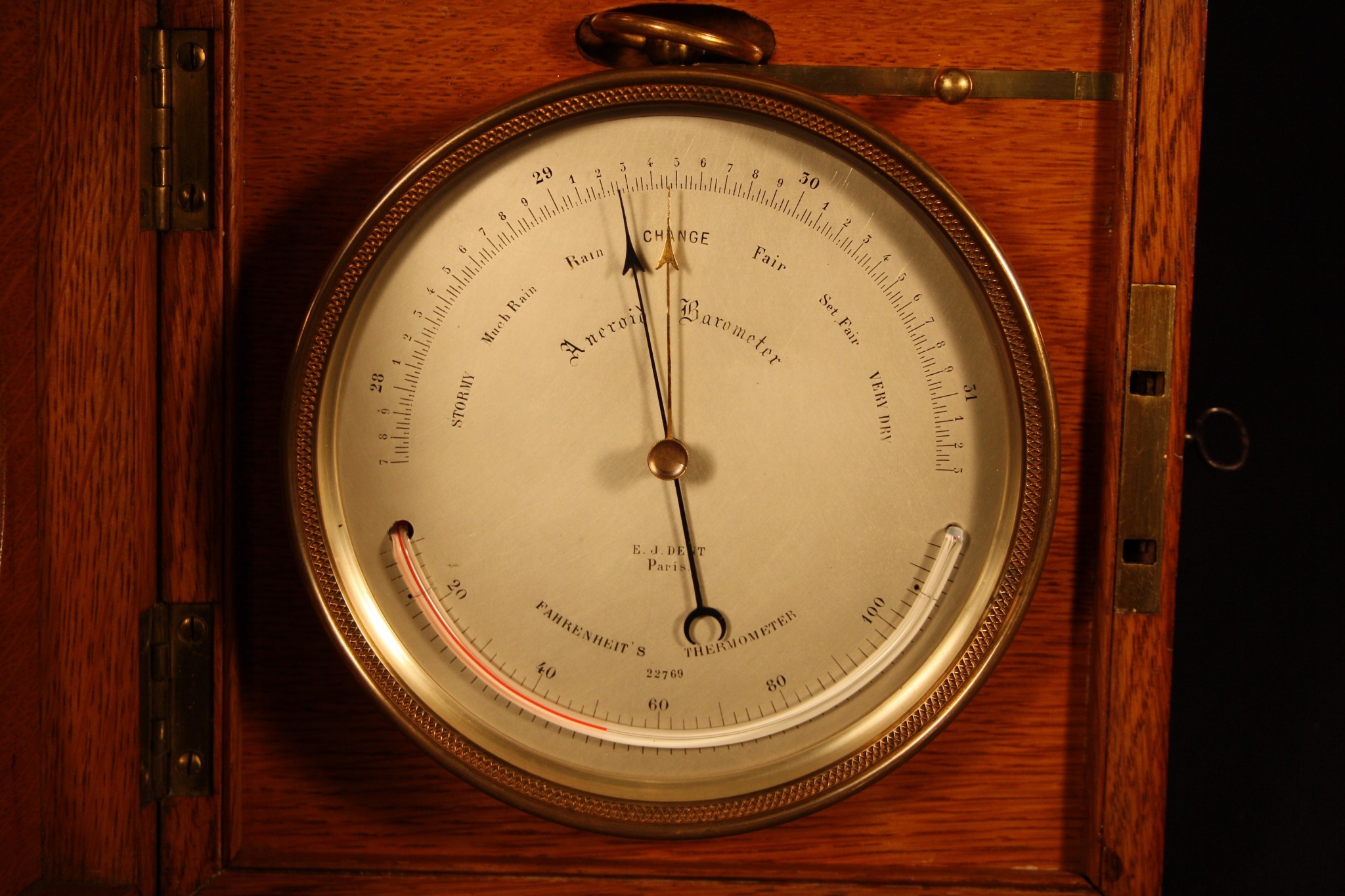A fine, lacquered brass desk barometer by EJ Dent, Paris, No 22769, with rare innovative movement, c1860
Aneroid barometer having silvered brass 4½” dial annotated “Stormy,” “Much Rain,” “Change,” “Fair,” “Set Fair,” “Very Dry,” calibrated from 27½-31½ inches of mercury, further annotated “Aneroid Barometer” in script. The lower portion bearing the retailer’s legend “E.J. Dent, Paris,” “Fahrenheit’s Thermometer” and serial no. “22769,” and having curved spirit thermometer calibrated from 10-114 degrees Fahrenheit. Blued-steel pointer and gilt brass telltale. Flat glass, with fine knurled gilt brass telltale adjustment wheel to centre. Lacquered spun brass case and bezel, the latter with trademark Dent herringbone pattern. Set pillar with suspension ring to top. The reverse with screw calibration port set at 3 o’clock as viewed. The whole contained within its original rare-pattern lacquered oak, flat top case with circular glazed viewing port, having bronzed and lacquered brass ring to circumference, internal brass sliding locking catch designed to securely hold the instrument, rear mounted pull out picture stand and extending brass hanging plate. High gloss lacquered interior with blue velvet-faced recess. Circular brass escutcheon and hinges set with brass screws, lock and key. The picture stand recess marked with the name “Major Reed, IMS” (Indian Medical Service).
The instrument movement having been cleaned and serviced, the brass case retaining much original lacquer, with some wear at contact points with oak display box. The box, having small repair to shrinkage crack at three o’clock, retaining much original lacquer, some wear to finish and minor abrasions consistent with age.
The movement in this Dent barometer is extremely unusual. Makers of these instruments at this time were aware of a number of shortcomings in the basic aneroid design: principal was the lack of linearity and a phenomenon known as hysteresis, endemic in the pressure sensing capsule. The mechanical connections within the movement resulting in hang up caused by static friction.
Dent, the genius innovator and mechanical engineer, attempted to address these issues. Lucien Vidi’s original design essentially entailed five pivot points in order to transmit and amplify the signal from the capsule to the head of the fusee chain connected to the arbour. Dent set out to substantially reduce the issue of friction, by changing the angles and positions of the interconnecting rods and levers and by causing them to interconnect at points, rather as a compass needle on a point. By changing the orientation of the cross shaft, placing it vertically from the horizontal, there became two principal bearing points of contact (from the original five), and with the instrument lying on its back as in a deck case, this essentially became one, that at the base of the now vertical cross shaft – the top also on a pivot might be largely discounted as this served only as a steady.
A further measure to address the issue of hang up was the fitting of a static mass lever, essentially a large weight mounted on a rod and extending in front of the C-spring. The rod is secured to a substantial cross shaft transversely mounted to the C-spring, connected to and directly above the centre of the capsule. The instrument would be affected when subjected to any vibration, including speech. These vibrations transmitted into the movement would cause it to oscillate as a result – the static mass being less affected, the difference in amplitude of these oscillations causing any remaining static friction to be released.
This is a fascinating study in innovation and development of the aneroid system, encompassing some of the most significant major changes to the original design to date. Without doubt the work of one of the world’s leading horological and instrument technicians.
Only three of these instruments have been identified to date: serial nos 22175, 22720 and 22769. A narrow band in manufacturing terms, it is not known if the production was consecutively numbered – however this shows a dispersion of some 600 instruments assuming 22175 is correctly read.
Surgeon-Major Augustus Keppel Reed (1832-1881) was a medical officer in the 44th Sylhet Light Infantry, part of the Bengal Army and, in a later evolution, the Gurkhas.
The Indian Medical Service (IMS) was a military medical service in British India, which also had some civilian functions. It served during the two World Wars, and remained in existence until the independence of India in 1947. Many of its officers, who were both British and Indian, served in civilian hospitals.
Dimensions: 6½" wide x 6¾" deep x 3" high
Stock No: BA0228
Price: Vavasseur Archive - not currently for sale



